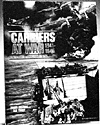
Designed by Roger Keating
and Ian Trout
Strategic Studies Group
1747 Orleans Ct., Walnut Creek,
CA 94598
Released: June, 1984
Catalog No. 102 (Apple)/202
(C-64)
Price: $50.00
Complexity: Advanced
Solitaire Suitability: Excellent
*****
First it was the Bee Gees, then the America's Cup. Now war games have fallen to the invincible Aussies. Carriers at War (CAW) is Strategic Studies Group's new computer simulation game, designed by duo Roger Keating and Ian Trout, and it is a marvel. From the easy, step by step instructions to the wealth of detail, CAW is, quite frankly, the best computer game I've seen. This review is based on the Apple II version.
Winner of the 1984 Charles Roberts Award for adventure computer games, CAW combines an easy-to-use program with an extensive yet well-organized detail framework. its price, $50, is a bargain considering all that comes in the game. Although its cover is average, the total packaging is in Strategic Studies Group's unique folder format. But don't judge this one by its cover.
CAW gives a player command over Allied or Japanese forces in five WWII battle scenarios: Coral Sea, Midway, Santa Cruz, the Eastern Solomons, and the Philippine Sea. There are provisions for human or computer control of various forces, and several players could conceivably share command of multi-division group. The most common set-up is likely to be two players head-to-head or one player vs. the computer.
An additional scenario is a Pearl Harbor tutorial game. Strategic Studies Group has been including dry-run, teaching games with its products and this one is ideal. The directions are simple and readable. Some cross referencing is necessary to figure out which of the 20-plus menus is which, but this poses no major problem. Between the tutorial and the manuals, CAW is easy to learn.
This is a game of strategy. There's precious little luck involved, and such luck as there is (locating the enemy fleets) usually comes from intelligent deployment. Play balance is of course affected by which scenario is played (example: Theres no way the U.S. can win at Pearl Harbor). But the other scenarios are well enough balanced that a player can take either side and have a reasonable go at it.
As innovation goes, this game is remarkable for two reasons: One is the sheer mass of relevant detail Trout and Keating crammed into it. Second is the design-your-own-scenario option. This is time-consuming but so well explained in a separate manual that it's not a "genius only" option.
Fun? Yes! CAW is tedious at first, roaming around looking for action. But then you spot the enemy and arm your planes. Will they get through? Will the enemy find you first? Long range carrier warfare was a nail biting affair, not a Bismarck-like cathartic wham-bang. As authenticity goes, CAW is as close as any map and readout game is likely to be.
The complexity of CAW guarantees its value and its sophisticated options keep the game fresh. if some fanatic DOES play the thing to exhaustion, there's always the do-it-yourself.
No game is perfect. Like all other computer simulations, CAW has gaps in the rule book. Don't forget to arm your planes or they'll drop duds. Be careful moving your ships, or your air wings can get lost and land in the drink. These and other pitfalls were uncovered trial-and-error.
But we quibble. Over-all, CAW is complex, elegant, realistic, enjoyable, and very accessible. If you're thinking of moving up from intermediate to advanced level computer gaming, this is the vehicle. if you're already on advanced level, Carriers at War will be a delight.
More War Game Reviews
-
Game Review: Operation Winter Storm: Stalingrad
Game Review: Ace of Aces Balloon Busters WWI Air Combat Game
Game Review: Carriers at War, 1941-45 Fleet Operations in the Pacific
Game Review: Rolling Thunder Air War Over North Vietnam
Game Review: Operation Market Garden
Game Review: Stellar Conquest
Back to Table of Contents -- Game News #10
To Game News List of Issues
To MagWeb Master Magazine List
© Copyright 1985 by Dana Lombardy.
This article appears in MagWeb (Magazine Web) on the Internet World Wide Web.
Other military history articles and gaming articles are available at http://www.magweb.com